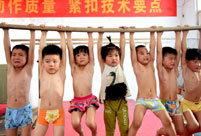 Happy life in Xinjiang
Happy life in Xinjiang
 2014 China Hainan Int'l Automotive Exhibition kicks off
2014 China Hainan Int'l Automotive Exhibition kicks off
 Collection of 'China Dream' public-spirited ads
Collection of 'China Dream' public-spirited ads
 The silent holy stones
The silent holy stones
 University students take care of giant pandas
University students take care of giant pandas
 Leading lady a true legend
Leading lady a true legend
 China Pan-Asia Stone Expo held in Kunming
China Pan-Asia Stone Expo held in Kunming
 Taiwan woman marries into Kazak family, 100 sheep plus a flat as dowry
Taiwan woman marries into Kazak family, 100 sheep plus a flat as dowry
 College girls take graduation photos under water in Chongqing
College girls take graduation photos under water in Chongqing
 Cartoon: Xi and football
Cartoon: Xi and football
BEIJING, July 16 -- The plans of the emerging-market bloc of BRICS to establish a development bank usher in a long-awaited and helpful alternative to the Western-dominated institutes in global finance.
The bank, along with a currency reserve pool, is aimed at providing financial support for infrastructure and sustainable development projects in not only the five BRICS member states but also emerging economies worldwide.
That is a blessing for cash-strapped developing countries, whose funding applications to boost their poor roads and railways have been repeatedly rejected by international lenders which attach strict loan conditions.
These institutes, notably the U.S-led World Bank and International Monetary Fund, are known for their politicized way of choosing borrowers without due regard for each countries' individual circumstances.
Their prescriptive recommendations, including liberalization, deregulation and privatization, have proved not a panacea. While prospering some countries, they are failing others, especially in Africa.
The new BRICS bank provides a brand new possibility.
The bank is established by emerging economies for emerging economies.
With an initial authorized capital of 100 billion U.S. dollars, it is expected to contribute an alternative perspective on how developing countries should be financially helped to achieve sustainable development.
It reflects developing countries' understanding of how the world financial system should be remolded.
Along with the 100-billion-U.S.-dollar contingent reserve arrangement that will help countries forestall short-term liquidity pressures, the new bank is expected to strengthen the global financial safety net and complement existing international arrangements.
The diversification introduced by the new BRICS organ, however, should not be interpreted with a zero-sum mentality.
The needs for infrastructure investment in developing nations are obviously too massive to be financed by any lender single-handedly. It entails cooperation and coordination among existing financial institutes.
The World Bank estimated that South Asia needs to invest about 250 billion U.S. dollars a year to bridge the infrastructure gap over the next 10 years, while East Asia needs about 600 billion U.S. dollars annually.
With all the banks combined, their financing capacity will still fail to meet the emerging economies' needs to develop infrastructure.
In the the uphill battle against extreme poverty and poor infrastructure, new methods and modes are always worth trying.
For the Western media that are exaggerating the ambition and competition that comes with the new BRICS bank, they should remind themselves of what the World Bank President Jim Yong Kim has said, "There is more than enough business for everybody."
 Moms on their kid’s coming out
Moms on their kid’s coming out Chinese fighters through lens
Chinese fighters through lens
 Children attend gymnastics training in summer
Children attend gymnastics training in summer
 Beautiful sceneries along the special travel route in Xinjiang
Beautiful sceneries along the special travel route in Xinjiang
 Beauty SWAT member in Xinjiang sparks online frenzy
Beauty SWAT member in Xinjiang sparks online frenzy
 Germany beat Argentina 1-0 to win World Cup
Germany beat Argentina 1-0 to win World Cup
 National fitness team members integrate traditional and modern beauty
National fitness team members integrate traditional and modern beauty Collection of 'China Dream' public-spirited ads
Collection of 'China Dream' public-spirited ads  How Chinese men kill the time when their wives practice square dancing?
How Chinese men kill the time when their wives practice square dancing? China's largest 3D printer builds 2-meter-long boat
China's largest 3D printer builds 2-meter-long boat
 One-legged women with high heel goes viral on Internet
One-legged women with high heel goes viral on Internet Photos of the Week
(July 6 - July 12)
Photos of the Week
(July 6 - July 12)
 'Super moon' seen in Beijing
'Super moon' seen in Beijing
 Happy life in Xinjiang
Happy life in Xinjiang
 'Finding Nemo' in Seattle Aquarium
'Finding Nemo' in Seattle AquariumDay|Week|Month